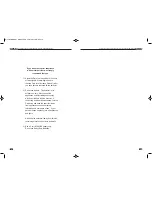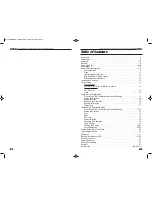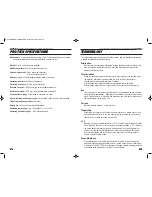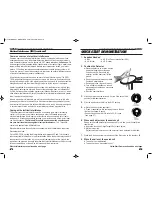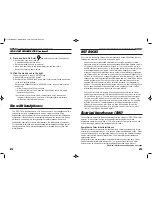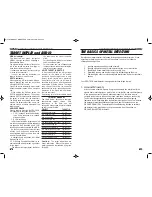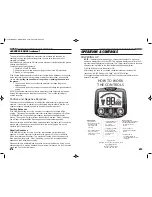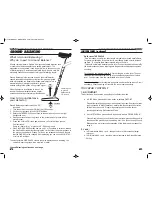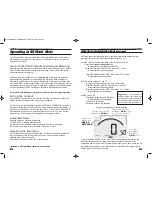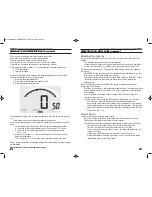
27
Comprehensive Operating Manual & Guide to Metal Detecting
PRO-TECH
HOT ROCKS
A hot rock is a rock which causes the metal detector to sound off because the rock
contains iron minerals. They come in two basic types.
Negative hot rocks
(also called cold rocks) are usually magnetite or contain
magnetite, and give a negative response because their ground balance value is
a higher number than the soil they are found in. They tend to be dark in color,
usually black, and usually heavy. In some cases they will have rust stains. They
are usually attracted to a magnet. In All Metal Mode, negative hot rocks
produce a
boing
sound rather than the
zip
sound of a metallic target; recognize
the difference and you will learn to ignore them. As the searchcoil passes over a
hot rock, this
boing
sound, or negative response, is quite distinctive. To hear this
response, you must be properly Ground Balanced and in All Metal Mode with an
audible threshold hum. First, as the center of the searchcoil passes over the
negative hot rock, the detector will go quiet; the threshold hum momentarily
silences. Then, passing beyond the negative hot rock, you hear the
boing
sound.
As you pass the searchcoil back and forth over a negative hot rock, it will be
impossible to pinpoint and will seem as if it
moves around
.
Positive hot rocks
are iron-bearing rocks which have been oxidized by natural
weathering processes so that their ground balance value is a number lower than
the soil they are found in. They are usually, but not always, drawn to a magnet.
They are most often reddish in color but are often black, brown, or yellow. On
some sites, red clay bricks and rocks which have lined a fireplace or a campfire
will often be
hot rocks
. The discriminator will usually eliminate them without
difficulty if widely scattered, but if there is a large concentration of them, the
discriminator may not quiet them all. In that case, you can revert to the rule of
thumb -- “don't dig non-repeatable signals.”
Electrical Interference (EMI)
You are likely to encounter electrical interference when using your PRO-TECH metal
detector. It is important that you recognize electrical interference and take
appropriate measures to deal with it. This will prevent you from giving up on a site,
or from returning a properly functioning detector for repair.
Symptoms of electrical interference
Electrical interference can cause a metal detector to
chatter
spontaneously, to lose
sensitivity for no apparent reason, or to cause a periodic
wobbly
audio sound. What
you hear will depend on what operating mode you are using, the detector's settings,
and the source of the electrical interference. The most common manifestation is
spontaneous chatter.
All metal detectors are susceptible to electrical interference, but they vary in what
kinds of electrical interference affect them. In a given environment some metal
detectors may be affected by electrical interference whereas others may not.
Electrical Interference continued on next page
10
PRO-TECH
Comprehensive Operating Manual & Guide to Metal Detecting
QUICK-START DEMONSTRATION (continued)
9. Press-and-hold Pin Point
and hold the nickel over the searchcoil
a. Notice that motion is not required.
A motionless object induces a hum.
b. Notice the variable pitch & volume hum.
c. Move the nickel closer to and farther away from the searchcoil.
Notice the changing “depth” values.
10. Click the mode knob to the right
The detector is now in the ALL METAL Mode
a. Keep GAIN set at the 12:00 position
b. Rotate the THRESHOLD knob slowly from the far counterclockwise position
to the full clockwise position.
Notice these attributes of the THRESHOLD control, with no metal over the
searchcoil.
i. at low settings you will hear no sound
ii. at mid-scale, there will be a transition point from no sound to a barely
audible, choppy sound.
iii. at full scale you will hear a loud, constant tone. It may also have an
irregular or choppy sound, as a result of electromagnetic interference
emitted from other electrical devices.
Use with headphones
The PRO-TECH is equipped with a 1/4” headphone jack. Any headphones with a
stereo plug will work; headphones with a mono plug will not work. Using
headphones extends battery life, and also prevents the sounds from bothersome
bystanders. It also allows you to hear subtle changes in the sound more clearly,
particularly if searching in a noisy location. For safety reasons, do not use
headphones near traffic or where other dangers, like rattlesnakes, are present.
This device is to be used with interconnecting cables/headphone cables shorter
than three meters. Fisher stereo headphones are included with your Pro-Tech
Metal Detector.
ProTechMANUAL_MPROTECH 1/28/15 8:14 AM Page 20


